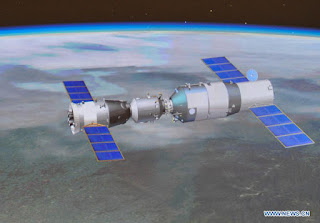Cosmonaut Yurchikhin outside the ISS.
It wasn't a week of ONLY International space activity, but I thought I'd post some of the goings-on by our ISS partners the Russian Space Agency and the conclusion of the Chinese Shenzhou 10 mission. On June 24, Expedition 36 flight engineers Fyodor Yurchikhin and Alexander Misurkin completed a successful six and one half hour spacewalk outside the ISS. The main reason for the EVA was to continue hookup preparations for a new Russian-built ISS Module, coming later this year, that will replace the PIRS module. That project will be the first renovation of the station since its completion at the end of the Space Shuttle program.
Cosmonaut Misurkin works on the Zarya module.
During the spacewalk, the cosmonauts also retrieved some experiments that had been outside the station exposed to the vacuum of space, and did some preventative maintenance on the Zarya module cooling system. There are four more Russian spacewalks scheduled for 2013, and two spacewalks by Americans in July.
Outside the ISS.
During the spacewalk, the Expedition 36 crew continued on working with ISS equipment or were involved in supporting the EVA. Due to the layout of the Russian module segments and their hatch locations, astronaut Chris Cassidy and Commander cosmonaut Pavel Vinogradov were required to remain in the Soyuz 08M craft attached to the Poisk module, while the other two astronauts were free to move about the American side of the station.
Soyuz 2-1b rocket on launch pad.
The Russians also had a busy launch schedule. On June 25, they launched a Soyuz 2-1b rocket from Baikonur and paced a remote-sensing satellite in orbit. Then on June 26, a Soyuz ST-b rocket lifted off from the European Space Agency launch site in French Guiana, carrying four satellites designed to expand broadband Internet communications to areas of the planet that currently have weak or no coverage.
Televised parachute opening of returning Shenzhou-10 capsule.
June 26 also saw the ending of China's Shenzhou-10 space station mission. Declaring a success, China's crew landed in Inner Mongolia safely and was returned to a cheering nation. China will now focus on building the technology for a new station and expanded series of ferry rockets for carrying crew and supplies.








































